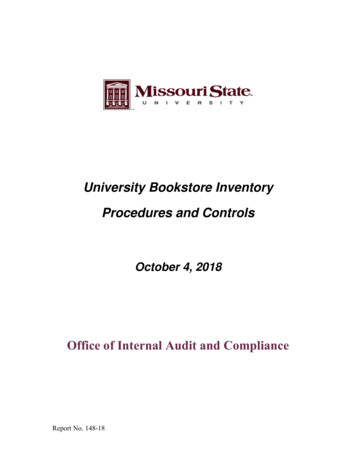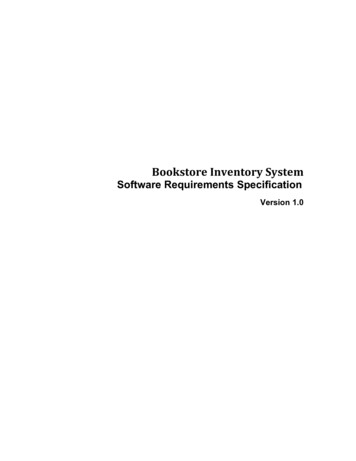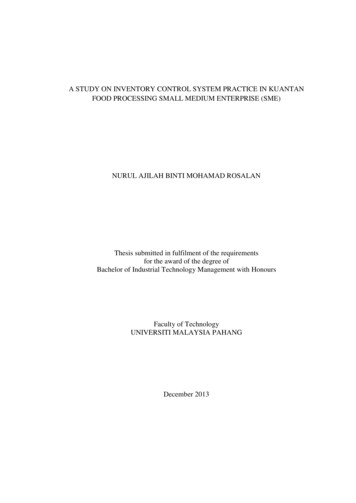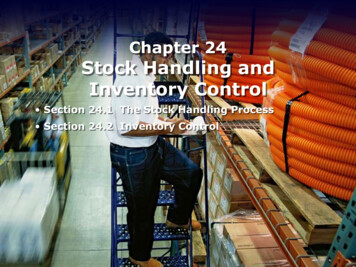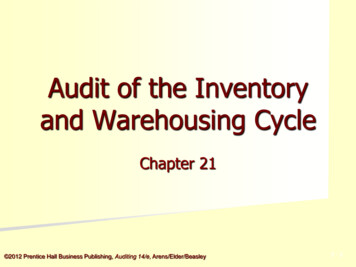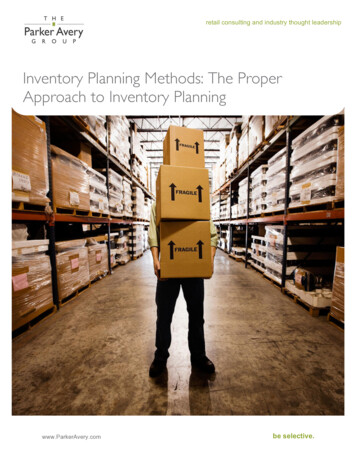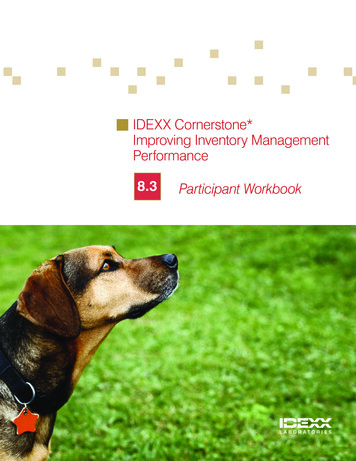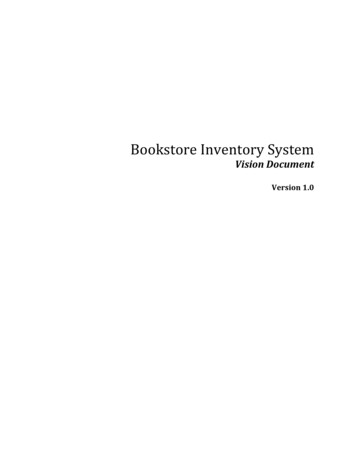
Transcription
BookstoreInventorySystemVisionDocumentVersion1.0
Revision HistoryDate9 Oct 2010Version0.1DescriptionInitial DraftAuthorHo Nam HoGerson RecinosJemar MillerDavid Altum10 Oct 20100.2Database, features reviewedHo Nam HoGerson RecinosJimar MillerAdam WurtzelDavid AltumFinan BariagabrFrancisco Diaz16 Oct 20100.3Rough draftHo Nam HoGerson RecinosJimar MillerAdam WurtzelDavid AltumFinan BariagabrFrancisco Diaz23 Oct 20101.0Final DraftHo Nam HoGerson RecinosJimar MillerAdam WurtzelDavid AltumFinan BariagabrFrancisco Diaz
TABLE OF CONTENTS1.2.3.4.5.6.7.INTRODUCTION . 41.1.Purpose. 41.2.Scope . 41.3.Definitions, Acronyms and Abbreviations. 41.4.References. 41.5.Overview. 4PRODUCT FEATURES . 52.1.Manage Books. 52.2.View Books. 52.3.Manage/View Books Prices. 52.4.Transactions . 52.5.Databases . . 52.6.Manage Rented Books. . 62.7.Reports. . 62.8.Alerts and Purchase Order Suggestions. 6CONSTRAINTS . 6QUALITY RANGES . 64.1.Reliability. 64.2.Availability . 64.3.Usability. 64.4.Fault Tolerance. . 64.5.Supportability. . 74.6.Functionality. 74.7.Performance . 7PRECEDENCE AND PRIORITY . 75.1.High Priority. 75.2.Medium Priority. 75.3.Low Priority. 7OTHER PRODUCT REQUIREMENT . 76.1.Applicable Standards. 76.2.Environmental Requirements. 76.3.Platform Requirements. 76.4.System Requirements. 76.5.Performance Requirements. 8DOCUMENTATION REQUIREMENTS . 87.1.User Manual . 87.2.Online Help. 87.3.Installation, Guides, Configuration and Read Me File . 87.4Labeling and Packaging. .8
VisionDocument1. Introduction1.1. PurposeThe purpose of this document is to define the high level requirement of the BookstoreInventory Software System.1.2. ScopeThis program will be used as an all-around back-end bookstore inventory system. Some ofthe key features of the system are the following. The software will enable the client(business) to have real time statistics of sales and book inventory, automatically produceEnd of Day sales reports and End of Day low-inventory notices (purchase ordersuggestions).It will also enable the users (customers) to view the real time inventory and extract bookinformation, enable users to place orders online and pick up books in-store and access to apersonalized account profile, order history, etc.Lastly, the program will enable vendors to have access to part of the system – it will allowany vendor to update book information, add/remove new books to/from the inventory andupdated prices.1.3. Definitions, Acronyms and AbbreviationsThis is a comprehensive list of all terms used in this vision document.POS (Point of Sale) – an electronic terminal that handles all credit/cash transactions.Vendor – A company/person who is in the business of selling products and goods tobusinesses.Inventory – a detailed list of goods and materials that are in stock.User – a person who can interact with the software – can be an employee or end user(customer).Client – the UNLV bookstore.Book Inventory – the detailed list of books in stock.Database (DB) – an organized (structured) body of related information.End of Day Report – a report that is done after business hours are over. Typically, it includessales and inventory.Sales – the overall money transaction during a specified time interval.Transaction – the exchange of goods or services for legal tender.1.4. ReferencesNone.1.5. OverviewIn the following sections we outline the software product in higher detail. We will start withdefining the key features that will be implemented. Next, we will discuss the constraints thatwill be imposed upon the software and the quality ranges, in other words, the robustness,
fault tolerance and usability of the software product amongst other things. In theprecedence and priority section we will comment on the most important functionalities thatthe software product must have and the integrity of the sales system.In the following sections will discuss all other product requirements, such as, performancerequirements, platform requirements and environmental requirements. Lastly, we willcomment on the documentation requirements, such as, user manuals, online help &support, installation and packaging.2. Product Features2.1. Manage BooksThe product must be able to adequately manage the books that the bookstore receives.Therefore the database will sort books via ISBN, author name, class subject (i.e.- CS472,CPE100, etc), title, department name, etc.2.2. View BooksThe system must be able to provide an interface to view all books that are available. Thisfeature will allow the user to check whether a book is available for purchase. An employeemay also request a list of books that can be categorized by author, title, class subject, ISBN,etc.2.3. Manage/View Books PricesThe product must allow the bookstore to update the pricing of their books. Access to thisfeature must be limited only to essential personnel. The access must be protected by meansof login and password. Every individual with access to this feature must have a separatelogin and password. The product must be able log and record the price changes made, thetime and date of the price change, and the person that made the change.It must also have an interface for vendors to update their corresponding book prices. Thisfeature will simplify and improve the communication between the bookstore and allvendors.2.4. TransactionsThe product must be able to interface the sales registers (POS system) with the database inorder to update the total count of each book available in the bookstore at a given time.When a book is sold the system must reduce the number of that book available by one.When a book is returned the system must increase the number of that book by one.2.5. DatabasesThe product will need to manage three databases in order to do its intended operation. Thefirst is a database to manage all the books available in the bookstore. This database will beorganized in a number of different categories. For example, we can lookup books byauthor’s, subject, ISBN, how many in stock, how many new and used, how many in order,if its for rental, the price of the book, etc .The second database will manage and keep track of all transactions. There will be differentways in which information can be retrieved. For example, we can query information based
on date of transaction, receipt number, etc.The third database will manage all customer information. This database will keep track ofthe customer’s name (first, middle, or last), home address, email address, phone number,and history of rented books.2.6. Manage Rented BooksThe system must implement a function to allow a bookstore to keep track of rented bookand when they are due.2.7. ReportsThe system must be able to generate reports based on give parameters, such as, dates,specific book, publisher, etc. The report will provide information on sales and inventory.2.8. Alerts and Purchase Order SuggestionsThe system will be able to automatically generate low stock inventory alerts. A purchaseorder suggestion will also be generated based on the inventory of a particular book.3. Constraints The number of books is dependent on employees inputting information correctly and thesystem functioning in the desired manner. The system must be connected with external hardware, such as, registers and servers. A back up system must be incorporated. A website is incorporated into the system.4. Quality Ranges4.1. Reliability The system shall be designed to be robust and be able to handle a large amount oftraffic. The system must be able to handle improper user input. The system shall be designed in a manner that is free of security flaws.4.2. AvailabilityThe system shall be available to users during the specified time that the client chooses (24hours, business hours only, etc.)4.3. UsabilityThe system shall enable the users to navigate and perform operations in an intuitive andeasy manner. The user interface must allow the user to search for the books in a timelymanner. Also, vendors must access the system in a secure manner and the bookinformation. However, they should have this capability during the business day but notaffect the business operations of the bookstore.4.4. Fault ToleranceThe system must be designed to be robust, especially during the start of the fall, spring, andsummer terms. If a crash happens, a simple switch to a backup or reboot fixes the problemtemporarily so that the software remains operational. The software must be able to handleimproper user input. The system shall also be designed in a manner which is free of
exploits.4.5. SupportabilityThe system shall be designed for easy maintenance and upgradability. The system will bedesigned to handle a large and diverse load at peak times at the start of each semester. Thesystem must continue operating at a constant pace with a maximum load.4.6. FunctionalityThe system shall be designed such that a user can query information stored in thedatabases. For example, query a book by author, title, ISBN, publisher, etc.The system shall be designed for easy navigation. Also each separate database can bemodified to tailor a client’s needs. The system shall be able to provide all the systemfeatures as outline in previous sections.4.7. PerformanceThe system shall be designed to handle a large amount of traffic.5. Precedence and Priority5.1. High Priority Input from registers. Price updates from vendors/staff.5.2. Medium Priority none.5.3. Low Priority End of day sales and inventory reports Purchase order suggestions User interfaces.6. Other Product Requirement6.1. Applicable StandardsTCP/IP, UL and ISBN standard.6.2. Environmental RequirementsThe environment of the system is in the student book store at room temperature and is tobe self-contained.6.3. Platform RequirementsIn order to maintain easy upgradability and robustness, the software product will bedeveloped for the UNIX platform.6.4. System RequirementsThe product must have an interface with the printer/printers of the store in order to printthe necessary report.
It should be designed so that possible updates and maintenance can be done as effortlesslyas possible. If a system crash should occur there should be back up files so that the systemmay be restarted.6.5. Performance RequirementsThe product must minimize the amount of time spent updating and organizing thedatabases.The access time to the databases must not exceed 1s seconds.The system is expected to be highly dependable and highly unsusceptible to crashes.Searches and updates to the database must be done in real time and therefore as quickly andefficiently as possible. It should be specifically designed to operate smoothly under thebusiest conditions.7. Documentation Requirements7.1. User ManualA user manual will provided as a pdf document to staff. It will outline, in detail, the system’sfunctions.7.2. Online HelpSystem documentation will also be available online, it will include the user manual, FAQsection and an email support system.7.3. Installation, Guides, Configuration and Read Me FileThe installation guide and configuration guidelines will be provided as part of the Read Mefile which is included as a .txt file.7.4. Labeling and PackagingThe software will be packaged for the unix environment running Apache, SQL and PHP.Labeling will include all icons, copyright information and any applicable trademarks.
This program will be used as an all-around back-end bookstore inventory system. Some of the key features of the system are the following. The software will enable the client (business) to have real time statistics of sales and book inventory, automatically produce End of Day sales rep

